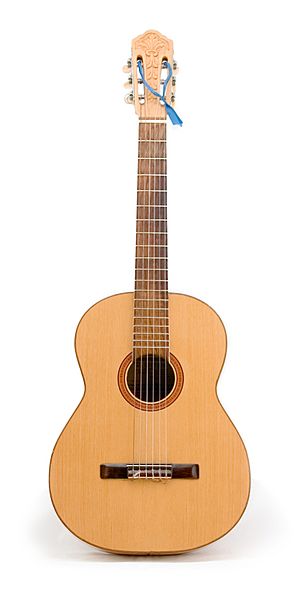Acoustic music facts for kids
Quick facts for kids Acoustic music |
|
|---|---|

A Spanish guitar
|
|
| Stylistic origins | |
| Cultural origins | Ancient |
| Typical instruments | |
| Other topics | |
Acoustic music is music made mostly with instruments that create sound naturally. This means they don't use electricity or electronic parts. Think of a regular guitar, not an electric one!
Long ago, all music was acoustic. But when electric instruments like the electric guitar or synthesizer came along, people started using the term "acoustic music" to describe the older, natural way of making sounds. Acoustic instruments have always been important in popular music, especially in folk music.
Some people, like music reviewer Craig Conley, think that when music is called "acoustic" or "unplugged," it suggests other types of music might be too "noisy" with technology. They feel acoustic music is more "pure."
Contents
How Acoustic Instruments Make Sound
Acoustic instruments can be put into different groups based on how they make sound.
String Instruments
These instruments have strings that are pulled tight. When you pluck or bow the strings, they vibrate. This vibration creates sound. Examples include the guitar, violin, and cello.
Wind Instruments
Wind instruments are shaped like pipes. You blow air into them, and the air inside vibrates to make sound. The flute is a great example of a wind instrument.
Percussion Instruments
Percussion instruments make sound when you hit them. You might use your hands or a stick to strike them. Drums are a common type of percussion instrument.
History of Acoustic Music
The very first acoustic instrument was the human voice! We make sounds by pushing air past our vocal cords.
Early Instruments
The first instrument built by humans is thought to be the flute. The oldest flute ever found is an amazing 43,000 years old! It was discovered in Central Europe.
The Rise of the Guitar
By the 1800s, popular acoustic instruments looked a lot like today's guitars, but they were smaller. A Spanish instrument maker named Antonio de Torres Jurado helped change that. He made the bodies of these instruments bigger, creating what we now know as the modern guitar.
Guitars became very popular throughout the 19th century. More acoustic instruments were also created, like the double bass, which is a very large string instrument.
Acoustic Instruments in the 20th Century
As electric instruments became common in the 1900s, many stringed instruments were then called "acoustic." Instruments like the violin, viola, and cello, which make sound by vibrating their strings, are all acoustic.
The violin became very popular in the 1500s and 1600s. This was thanks to skilled instrument makers like Antonio Stradivari and Andrea Amati. The modern violin slowly developed from older European string instruments.
See also
 In Spanish: Música acústica para niños
In Spanish: Música acústica para niños

